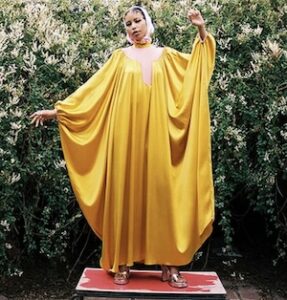Flowing; the Art of the Body: Iggy Pop and the Nude Artistic Tradition
By Jo Phillips
When we read the word “flowing” many things come to mind. A river, a waterfall, or elements that are generally related to water. However, flowing can also be linked to music, like the flowing of a melody that passes through our ears or the fascinating movements of a singer on stage. It can also be linked to the history of art when our eyes move and follow the swirling and elegant lines of a painting or a drawing. There is a connection between these two fields, and they incredibly intertwine around a particular figure: Iggy Pop.
How is one of the icons of rock connected to the academic discipline of the history of art?
Two current exhibitions, “Iggy Pop Life Class” and “Michelangelo and Sebastiano,” seem to answer this question. The flowing of Iggy’s body movements and the powerful flowing of the lines and contours of Michelangelo’s and Sebastiano’s drawings represent a recurrent theme in the western tradition: the aesthetic of the body and its art.
Iggy Pop wearing silver-lane evening gloves on stage at the Whisky, May 1970
from “Iggy and The Stooges: One Night at The Whisky 1970” published by ACC Art Books
Photographs by Ed Caraeff
“I use my body as an object of commerce”
Iggy Pop
Iggy is one of the icons of rock. “Iggy Pop and the Stooges: One Night at the Whisky 1970” is a book that is coming out this June and that is going to show the essence of this Rock character. In May 1970, Iggy Pop gave some performances at the Whisky, and the photographer Ed Caraeff was there that night. He managed to catch the energy, the powerful and overwhelming madness of Iggy Pop’s spectacles. However, the most recurrent feature of the photographs seems to be one: Iggy with his shirt off.
“I saw the Pharaohs with no shirts and I thought, ‘It just looks so classic. I have a long torso. I could do that.’”
Iggy Pop
His work was also based on the importance of the body. “I use my body as an object of commerce, ” he said to the artist Jeremy Deller. The idea of showing the torso came to Iggy’s mind when he saw how Pharaohs were depicted. He, in fact, said to Total Chaos: “I saw the Pharaohs with no shirts and I thought, ‘It just looks so classic. I have a long torso. I could do that.’”
“That’s what Iggy actually is: an ancient, mythological figure, but in contemporary form”
Jeremy Deller
Pharaohs were considered both human and divine by the Egyptians. In other words, he wanted to imbue his character with a sort of demigod appearance. Deller, in fact, describes the icon of rock with the following words: “That’s what Iggy actually is: an ancient, mythological figure, but in contemporary form.”
Guno Park
Untitled (Sitting pose)
from “Iggy Pop Life Class” by Jeremy Deller, 2016
Brooklyn Museum Collection
Black ballpoint pen on paper
15 x 11¼ in. (38.1 x 28.6 cm)
Photo: Sarah DeSantis
“There are hundreds of thousands of photographs of him, but very few drawings. I thought his body deserves to be looked at differently, to be taken more seriously, in a way that would connect him to art history.”
Jeremy Deller
His body, surrounded by this mythological halo, became an appealing object of representation. In February 2016, he posed nude in front of the artists of the New York Academy of Art. Jeremy Deller and the Brooklyn Museum organised the exhibition “Iggy Pop Life Class” gathering a lot of material from the academy.
Deller about this exhibition says: “There are hundreds of thousands of photographs of him, but very few drawings. I thought his body deserves to be looked at differently, to be taken more seriously, in a way that would connect him to art history.”
The drawings of the New York Academy of Art exposed at the Brooklyn Museum align Iggy’s iconic body with the history of art. In some drawings, he is represented like a modern seated Zeus or Jupiter, linking him to the Greco-Roman classical tradition. The sketches represent his nude body and his muscles, recalling the western tradition of the “disegno” (drawing).
Taylor Schultek
Untitled (Seated pose)
from Iggy Pop Life Class by Jeremy Deller, 2016
Brooklyn Museum Collection
Graphite pencil with erasing on paper toned with graphite
15 1/16 x 10½ in. (38.3 x 26.7 cm)
Photo: Sarah DeSantis
The art of drawing, during the Renaissance (15th – 16th century), became the principal concern for any artist, especially in Florence. In the workshops, the pupils had to learn how to draw everything, especially the human body. It was the main interest for characters such as Leonardo, Michelangelo and Raphael. Michelangelo in particular thought that the human body was the unit of measure of the universe, the principal feature of Greco-Roman art and the perfect reflection of the image of God.
“What spirit is so empty and blind, that it cannot recognise the fact that the foot is more noble than the shoe, and skin more beautiful that the garment with which it is clothed?”
Michelangelo
Michelangelo’s influence made the theme of the “nude” one of the main subjects of western art. His words explain better than anyone else his concern for the human body: “What spirit is so empty and blind, that it cannot recognise the fact that the foot is more noble than the shoe, and skin more beautiful than the garment with which it is clothed?” In the exhibition “Michelangelo and Sebastiano” there is a wide range of paintings and drawings that elucidate Michelangelo’s artistic view. His art paved the way to the period of the “Mannerism,” in which artists such as Sebastiano del Piombo forged their art following Michelangelo’s steps. The most evident connection between Michelangelo and Sebastiano is the monumentality of the human form, its stunning anatomical and muscular features. Features that, for instance, are notable in both artists’ drawings of rising saints or of Christ’s muscular and majestic body in the Resurrection.
Michelangelo Buonarroti
Christ at the Column
1516
Black chalk and white body colour over stylus indentation on paper
27.4 × 14.3 cm
The British Museum, London
© The Trustees of The British Museum
Michelangelo Buonarroti
Study for Ignudo (recto)
about 1510-1511
27.2 x 19.2 cm
© Albertina, Vienna
Sebastiano del Piombo
God the Father
about 1532-3
Black chalk and white body colour on paper
30.1 × 23.7 cm
Royal Collection Trust / © Her Majesty Queen Elizabeth II 2017
Music and Art, Rock and Drawing, all elements that flow to our eyes or to our ears and that sometimes, like in this case, get intertwined. To taste all of this, don’t loose the possibility to have a look at the current exhibitions and to buy the coming book about Iggy Pop.
Supplementary information can be found here:
“Iggy and the Stooges: One Night at the Whisky 1970” by Ed Caraeff. Published by ACC Art Book
“Iggy Pop Life Class,” Brooklyn Museum, November 4, 2016 – June 18, 2017
“Michelangelo and Sebastiano,” National Gallery, 15th March – 25th June 2017





![Study for Ignudo [front]; Study of Hands for the Pietà [back],](https://i0.wp.com/centmagazine.co.uk/wp-content/uploads/2017/05/Michelangelo-Sebastiano-X9021r_opt.jpg?resize=580%2C859)






